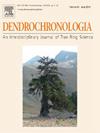Oxygen isotope dendrochronology allows dating of historical timbers across a wide geographical region
IF 2.7
3区 农林科学
Q1 FORESTRY
引用次数: 0
Abstract
We explore the applicability and geographic reach of two northwest European stable oxygen isotope (δ18O) chronologies for the precision dating of annually resolved δ18O series developed from late 15th-century oak (Quercus sp.) roof timbers from St. James’ Church in Bruges, Belgium. In doing so this study assesses ring-width dendrochronology and provenance analysis alongside oxygen isotope dendrochronology in Belgium and its surrounding regions. The δ18O-series of the historical timbers display a high internal coherence, allowing the construction of a mean isotope series (1325–1468 CE). Cross-dating against master chronologies for Central England, U.K. and Fontainebleau, France, provide reliable matches that surpass statistical thresholds and quality control measures, corroborating the dating results obtained from conventional ring-width dating. Oxygen stable isotope dendrochronology emerges as a valuable tool for precise dating of historical timber structures. This pilot study demonstrates the applicability of existing reference chronologies beyond their core regions and underscores its significance in cultural heritage studies. Despite the demanding nature of the technique in terms of time and expertise, the potential benefits warrant continued investment in expanding the temporal and geographic coverage of well-replicated oxygen isotope reference chronologies.
氧同位素树木年代学允许在广泛的地理区域对历史木材进行定年
本文探讨了两种欧洲西北部稳定氧同位素(δ18O)年表的适用性和地理范围,用于对比利时布鲁日圣詹姆斯教堂15世纪晚期橡树(Quercus sp.)屋顶木材的年分解δ18O系列进行精确测年。在此过程中,本研究评估了比利时及其周边地区的环宽树木年代学和物源分析以及氧同位素树木年代学。历史木材的δ 18o序列显示出较高的内部相干性,可以建立平均同位素序列(1325-1468 CE)。与英国中部英格兰和法国枫丹白露的主年表进行交叉测年,提供了可靠的匹配,超过了统计阈值和质量控制措施,证实了传统环宽测年获得的测年结果。氧稳定同位素树木年代学成为历史木结构精确定年的一种有价值的工具。这项初步研究证明了现有参考年表在其核心区域之外的适用性,并强调了其在文化遗产研究中的重要性。尽管该技术在时间和专业知识方面要求很高,但潜在的好处值得继续投资,以扩大复制良好的氧同位素参考年表的时间和地理覆盖范围。
本文章由计算机程序翻译,如有差异,请以英文原文为准。
求助全文
约1分钟内获得全文
求助全文
来源期刊

Dendrochronologia
FORESTRY-GEOGRAPHY, PHYSICAL
CiteScore
5.50
自引率
13.30%
发文量
82
审稿时长
22.8 weeks
期刊介绍:
Dendrochronologia is a peer-reviewed international scholarly journal that presents high-quality research related to growth rings of woody plants, i.e., trees and shrubs, and the application of tree-ring studies.
The areas covered by the journal include, but are not limited to:
Archaeology
Botany
Climatology
Ecology
Forestry
Geology
Hydrology
Original research articles, reviews, communications, technical notes and personal notes are considered for publication.
 求助内容:
求助内容: 应助结果提醒方式:
应助结果提醒方式:


